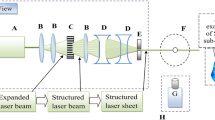Abstract
The quantified fuel mass distribution of a spray was obtained from laser induced fluorescence images with optical patternation. In the dense spray region, however, the emitted fluorescence signal is significantly attenuated in the path of the detector because of particle scattering. Thus, the fluorescence image obtained with a camera may be different from the true fluorescence image pattern. Therefore, we propose a method of finding the geometric mean of the intensities obtained with two cameras and apply it to a solid-cone spray. We also compared this optical patternation technique with other spray measurement techniques, such as, PDPA (Phase Doppler Particle Analyzer) and the mechanical patternator, to validate the accuracy of the proposed method. Results show that the quantified mass distribution of the optical patternator agrees well with those of the PDPA and the mechanical patternator. Hence, we can estimate the local mass distribution rapidly without determining the entire structure of the spray by using the geometric mean of the signals obtained from two cameras.
Similar content being viewed by others
References
Bohren, C. F. and Huffman, D. R., Absorption and Scattering of Light by Small Particles, (1983), Wiley Interscience, New York.
Jung, K., Koh, H. and Yoon, Y., Assessment of planar liquid-laser-induced fluorescence measurements for spray mass distributions of like-doublet injectors, Measurement Science and Technology, 14-8 (2003), 1387–1395.
Koh, H., Jeon, J., Kim, D., Yoon, Y. and Koo, J.-Y., Analysis of signal attenuation for quantification of planar imaging technique, Measurement Science and Technology, 14-10 (2003), 1829–1838.
Le Gal, P., Farrugia, N. and Greenhalgh, D. A., Laser Sheet Dropsizing of dense sprays, Optics & Laser Technology, 31-1 (1999), 75–83.
Lee, K., Jung, K., Yoon, Y., Jeong, I.-S. and Jeong K.-S., Semi-quantitative measurement of spray distribution using planar imaging technique, 2nd Asia-Pacific Conference on Combustion (Taiwan), (1999).
Lefevre, A. H., Atomization and Sprays, (1989), Hemisphere Publishing Corporation, New York.
McDonell, V. G., Lee, S. and Samuelsen, G. S., Interpretation of spray behavior in complex aerodynamic flows using phase doppler interferometry and planar liquid laser induced fluorescence, Optical Techniques in Fluid, Thermal, and Combustion Flow (San Diego, CA.), (1995).
McDonell, V. G. and Samuelsen, G. S., Assessment of liquid fuel distribution in sprays using planar imaging methods, 1st Asia-Pacific Conference on Combustion (Japan), (1997).
McVey, J. B., Russell, S. and Kennedy, J. B., High Resolution Patternator for the Characterization of Fuel Sprays, Journal of Propulsion and Power, 3-3 (1987), 202–209.
Raffel, M., Willert, C. E. and Kompenhans, J., Particle Image Velocimetry: a practical guide, (1998), Springer, New York.
Sankar, S. V., Maher, K. E., Robart, D. M. and Bachalo, W. D., Rapid characterization of fuel atomizers using an optical patternator, Journal of Engineering for Gas Turbines and Power, 121 (1999), 409–414.
Sick, V. and Stojkovic, B., Attenuation Effects on Imaging Diagnostics of Hollow-Cone Sprays, Applied Optics, 40-15 (2001), 2435–2442.
Su, J., Drake, M. C., Fansler, T. D. and Harrington, D. L., Towards quantitative characterization of transient fuel sprays using planar laser induced fluorescence imaging, ILASS-Americas 98 (Sacramento, CA.), (1998).
Talley, D. G, Verdieck, J. F., Lee, S. W., McDonell, V. G. and Samuelsen, G. S., Accounting for laser sheet extinction in applying PLLIF to sprays, 34th Aerospace Sciences Meeting and Exhibit, AIAA-96-0469 (Reno, NV.), (1996).
Tate, R. W., Spray Patternation, Industrial and Engineering Chemistry, 52-10 (1960), 49A-53A.
van Cruyningen, I., Lozano, A. and Hanson, R. K., Quantitative Imaging of Concentration by Planar Laser-Induced Fluorescence, Experiments in Fluids, 10 (1990), 41–49.
Wang, G., Deljouravesh, R., Sellens, R. W., Olesen, M. J. and Bardon, M. F., An optical spray pattern analyzer, ILASS-Americas 97 (Ottawa, Canada), (1997).
Zelina, J., Rodrigue, A. and Sankar, S., Fuel injector characterization using laser diagnostics at atmospheric and elevated pressures, 36th Aerospace Sciences Meeting and Exhibit, AIAA-98-0148 (Reno, NV.), (1998)
Author information
Authors and Affiliations
Additional information
Hyeonseok Koh: He received his Ph.D. degree and MS degree at School of Mechanical and Aerospace Engineering in Seoul National Univeristy in 2006 and 2001, respectively. Currently, he is a senior researcher of Korea Aerospace Research Institute(KARI). His research interests are visualization, laser diagnostics, such as 3D-PIV and optical patternator, and measurement technique for two-phase flow.
Kihoon Jung: He received his Ph.D. degree and MS degree at School of Mechanical and Aerospace Engineering in Seoul National University in 2004 and 2000, respectively. Currently, he is a senior research engineer of Hyundai Motor Company. His research interests are laser diagnostics, such as optical patternator and PLIF, visualization, and impinging type injector for liquid rocket injectors. Development of Quantitative Measurement of Fuel Mass Distribution Using Planar Imaging Technique
Youngbin Yoon: He received his MS degree at School of Mechanical and Aerospace Engineering in 1987 from Seoul National University and his Ph.D. degree at Department of Aerospace Engineering in 1994 from University of Michigan. After obtaining Ph.D. he worked as a researcher in University of California, Davis. And then he joined Seoul National University and currently is an associate professor. His research interests are visualization, laser diagnostics, supersonic combustion, turbulent diffusion flames and liquid rocket injectors.
Kyungjin Lee: He received his MS degree at School of Mechanical and Aerospace Engineering in 1999 from Seoul National University and his Ph.D. degree at Department of Aerospace Engineering in 2004 from University of Michigan. Currently, he is a postdoctoral research fellow of University of Michigan. His research interests are spray breakup, multi-phase turbulent flows and laser diagnostics.
Kyung-Seok Jeong: He received his Ph.D. degree and MS degree at School of Mechanical and Aerospace Engineering in Seoul National University in 1989 and 1983, respectively. Currently, he is a professor of School of Mechanical Engineering of Korea University of Technology and Education. His research interests are spray flow, laser diagnostics, and thermo-fluids visualization.
Rights and permissions
About this article
Cite this article
Koh, H., Jung, K., Yoon, Y. et al. Development of quantitative measurement of fuel mass distribution using planar imaging technique. J Vis 9, 161–170 (2006). https://doi.org/10.1007/BF03181759
Received:
Revised:
Issue Date:
DOI: https://doi.org/10.1007/BF03181759




